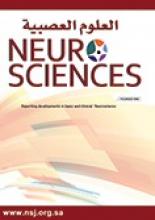Abstract
After a gap of approximately 20 years, a new generation of antiepileptic drugs (AEDs) has recently been developed. More than 8 drugs have been licensed in at least one country during the 1990s. While lamotrigine, gabapentin, vigabatrin and oxcarbazepine are widely used in some countries, felbamate, topiramate, tiagabine, levetiracetam, and zonisamide are still used on a narrow scale. A feeling of optimism occurs after the development of these drugs, although only a small number of epileptic patients become free of seizures after the addition of these new AEDs to their regimen. Generally, the safety profile of the new AEDs is only slightly better than that of established drugs and their efficacy is strongly associated with the use of high doses. This article reviews new AEDs by studying their clinical pharmacological effects, mechanisms of action as antiepileptic agents, side effects, drug-drug interactions and the appropriate regimen of their use.
- Copyright: © Neurosciences
Neurosciences is an Open Access journal and articles published are distributed under the terms of the Creative Commons Attribution-NonCommercial License (CC BY-NC). Readers may copy, distribute, and display the work for non-commercial purposes with the proper citation of the original work.






